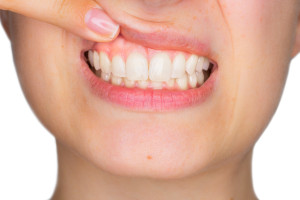 If you spend a lot of time brushing and polishing your teeth, you may think that you’re a dental hygiene superstar. But the real question is: What is the state of your gums? Just like brand new windows on a house with a shaky foundation, it doesn’t do much good to polish teeth that reside in unhealthy gums. If the gums where your teeth live are in bad shape, you may experience tooth decay and possibly even tooth loss. Keeping your gums in excellent condition is the key to healthy teeth.
If you spend a lot of time brushing and polishing your teeth, you may think that you’re a dental hygiene superstar. But the real question is: What is the state of your gums? Just like brand new windows on a house with a shaky foundation, it doesn’t do much good to polish teeth that reside in unhealthy gums. If the gums where your teeth live are in bad shape, you may experience tooth decay and possibly even tooth loss. Keeping your gums in excellent condition is the key to healthy teeth.
Why Gum Health Is So Important
Strong, healthy gums provide a nurturing environment for your teeth. However, if bacteria from tartar and dental plaque take up residence, the gum tissue may become infected. This puts you at a greater risk for bone loss, tooth decay and maybe even tooth loss. Advanced gingivitis (gum disease) is known as periodontal disease. People with gum disease are at risk for more serious medical conditions like diabetes, heart disease and dementia. If you’re pregnant, periodontal disease may even affect the health of your unborn child, leading to a premature birth.
How Do I Know If My Gums Are in Bad Shape?
There are some obvious warning signs that you need to take better care of your gums. Are they sensitive when you chew certain foods? Do they bleed whenever you brush your teeth, or when your dentist cleans them? Sensitive, bleeding and inflamed gums are a sure sign of the early stages of gingivitis. Left untreated, it can lead to periodontitis, which can have a permanent effect on the gum tissue, bone and ligaments. Keep a close eye on those gums! Healthy gums should be pink and firm.
Your Gums and Your Lifestyle Habits
The biggest lifestyle “no-no” for your gum health is tobacco and smoking. Having a poor diet with improper nutrition is also bad for your gums, as is stress. These factors compromise the state of your gums and put you at a greater risk of developing gum disease. Sticky plaque starts to form right after you brush, so it must be removed regularly. If not, it will start to calcify, and it will begin to spread below the gum line. Your immune system will kick in, trying to get rid of this hostile invader, and that will cause your gums to bleed and swell.
What Are the Worst Foods for Gums
Sugars from sweets and carbohydrates, acidic foods like citrus and coffee, plus hard or sticky foods can be especially difficult for your gums. However, any food is potentially a problem if you don’t practice daily oral hygiene (brushing and flossing), in addition to regular visits to your dentist.
How to Maintain Healthy Gums
Develop a daily habit of good oral hygiene to protect yourself against gum disease. Brush twice a day, and don’t forget to floss. Floss below the gum line to remove any plaque and food debris. Follow this with an antibacterial rinse to wash away debris and keep bacteria and plaque from forming. Visit your dentist regularly. In addition to cleaning, they’ll take X-rays every 12 to 24 months, to look for cavities, tartar and bone integrity, and will check for pockets in the gums, which are an early sign of periodontal disease.
No one’s perfect. If you happen to eat some delicious chocolate, have a cup of coffee in the morning or have a crunchy snack during the day, try to brush or at least rinse your mouth with water or mouthwash soon after. This will help to minimize the effects of those foods on your gums, for healthier gums and teeth.







Leave a Reply